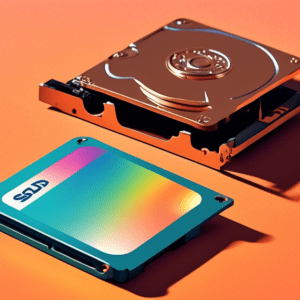Phison’s X100P: A Budget-Friendly 31TB SSD?
The world of data storage is on the brink of a seismic shift. While solid-state drives (SSDs) have long reigned supreme in terms of speed, their limited capacity and higher cost per gigabyte have kept hard disk drives (HDDs) relevant, especially for mass storage. However, Phison, a leading SSD controller manufacturer, is aiming to change the game with its groundbreaking X100P SSD controller. This innovative technology promises to deliver an unprecedented 31TB of storage capacity in a budget-friendly package, potentially dethroning HDDs in the race for affordable, high-capacity storage. But as with any technological leap, there’s a catch.
Unleashing the Power of QLC: The Secret Sauce Behind X100P
At the heart of the X100P’s impressive capacity lies QLC (quad-level cell) NAND flash memory. Unlike traditional TLC (triple-level cell) NAND found in most consumer SSDs, QLC NAND squeezes four bits of data into each memory cell. This denser storage architecture allows manufacturers to pack significantly more storage capacity into the same physical space, ultimately leading to lower costs per gigabyte.
Phison’s expertise in SSD controller design comes to the forefront with the X100P. The controller is engineered to maximize the potential of QLC NAND, mitigating its inherent limitations. QLC NAND, while denser, typically suffers from slower write speeds and reduced endurance compared to its TLC counterpart. However, Phison’s advanced controller algorithms and innovative firmware optimizations address these challenges, ensuring the X100P delivers a balance of capacity, performance, and longevity.
Performance Considerations: Balancing Act Between Speed and Endurance
While the X100P’s 31TB capacity is undoubtedly its headline feature, it’s crucial to understand the performance implications of this breakthrough. QLC NAND’s inherent characteristics necessitate a nuanced approach to performance optimization.
Write Speeds: The Trade-off for Capacity
QLC NAND’s increased density comes at the cost of write speed. Writing four bits to a single cell takes longer than writing three, as in TLC NAND. Consequently, users might experience slower write speeds, especially during sustained write operations. However, Phison’s X100P controller incorporates intelligent caching mechanisms and write amplification technologies to mitigate this limitation. For everyday tasks and typical workloads, the difference in write speeds might not be noticeable. However, demanding applications involving large file transfers or continuous data writing could expose the performance gap between QLC and TLC-based SSDs.
Endurance: A Balancing Act for Longevity
Another crucial aspect of SSD performance is endurance, measured in TBW (Terabytes Written). Endurance reflects the total amount of data that can be written to an SSD before its performance starts to degrade. QLC NAND, due to its denser structure, typically has lower endurance compared to TLC NAND. Phison, however, addresses this concern with its robust controller design and advanced wear-leveling algorithms. Wear-leveling ensures that data writes are evenly distributed across all NAND cells, preventing premature wear and tear on specific areas. While the X100P might not match the endurance of high-end TLC SSDs, Phison’s optimizations aim to provide a balance between capacity, performance, and a reasonable lifespan for the drive.
The Catch: A Paradigm Shift in Storage Usage
The Phison X100P’s arrival heralds a potential paradigm shift in how we perceive and utilize storage. While the promise of 31TB of affordable SSD storage is enticing, it’s essential to understand that this technology is optimized for specific use cases.
Ideal Applications: Where X100P Shines
The X100P’s strengths lie in scenarios requiring massive storage capacities without demanding peak performance. Consider these applications:
- Media Servers and NAS Devices: Storing vast libraries of movies, music, and photos benefits significantly from the X100P’s immense capacity.
- Archiving and Backup: Creating cold storage archives for infrequently accessed data becomes more cost-effective with the X100P’s low price per gigabyte.
- Surveillance Systems: High-resolution security cameras generate massive amounts of data, making the X100P an ideal storage solution.
Not Ideal: Where X100P Might Not Be the Best Fit
While the X100P excels in specific applications, it might not be the optimal choice for:
- High-Performance Workstations: Demanding tasks like video editing, 3D rendering, and software development benefit from the faster read and write speeds of TLC or NVMe SSDs.
- Gaming PCs: While the X100P can store a vast game library, its write speeds might lead to longer loading times compared to high-end NVMe SSDs.
Conclusion: The Dawn of Affordable, High-Capacity SSDs
The Phison X100P represents a pivotal moment in the evolution of storage technology. Its promise of 31TB of budget-friendly SSD storage has the potential to disrupt the market and challenge the dominance of HDDs in the realm of mass storage. While performance considerations and specific use case optimizations are crucial, the X100P paves the way for a future where affordable, high-capacity SSDs become the norm, transforming how we store, access, and interact with data.
As with any emerging technology, understanding the nuances of the Phison X100P is vital for making informed decisions about its suitability for your specific needs. As the technology matures and production scales, we can expect further refinements and optimizations, potentially bridging the performance gap between QLC and TLC SSDs while unlocking unprecedented storage capacities for a wider range of applications.
